Mercedes-AMG GLB 35 4MATIC roadtest review: Kiddy class kapow
/A $111k compact crossover offering family-hauling capability along with a raucous turbocharged performance engine might seem a strange brew, but it leaves a good taste.
Read MoreA $111k compact crossover offering family-hauling capability along with a raucous turbocharged performance engine might seem a strange brew, but it leaves a good taste.
Read More
Base Price: $92,900
Powertrain and performance: 2.0-litre four-cylinder DOHC 16-valve turbocharged petrol engine. 165kW/5500-6100rpm, 350Nm/1800-4000rpm. All-wheel drive. Combined cycle fuel consumption 7.7L/100km (claim), 8.2L/100km (road test).
Vital statistics: Length 4634mm, height 1659mm, width 1834mm, wheelbase 2859mm. Luggage 565 litres. Wheels: 19-inch alloys with 235/50 R19 Continental PremiumContact6 SSR tyres (run-flat).
We Like: Driving position and visibility, five-seat family wagon space and occasional third row versatility. Brilliant multi-beam headlight technology, intuitive MBUX infotainment and control system.
We don’t like: Aggressive lane departure interventions, compromised access to third row seats.
THE alphabetic sequencing suggests the new Mercedes-Benz GLB sits one-size-up from models carrying the `A’ designation.
And the knowledge that Mercedes-Benz has built its new GLB on the same transverse engine platform as the latest A-Class hatch - and derivatives including the CLA, GLA crossover and B-Class - points to a compact definition.
But slot it into a car park and the GLB actually seems larger. So, I checked and compared.
Do you remember the W163 Series ML introduced in 1997 as its first Mercedes-Benz foray into SUVs beyond the mighty G-Wagen? The GLB has a wheelbase dimension 40mm longer than the ML and is also 47mm longer overall.
Width measures up at an identical 1834mm but the ML stood 116mm taller and that is where the impression of larger size is gained.
The debut of the GLB offers a family wagon solution between the GLA crossover and the GLC mid-size SUV with a spacious interior layout that includes three-row seating.
Pricing begins at $78,900 for the entry level GLB 200 (front-drive) version and the GLB 250 4Matic (tested here) is priced from $92,900. The step to the GLB 35 AMG performance model adds another $12K.

The 1991cc direct-injection petrol engine is a staple across multiple Mercedes-Benz model lines and powers the GLB 250 4Matic with 165kW available between 5500-6100rpm and peak torque of 350Nm across a wide 1800-4000rpm range.
And one more comparison to the old ML - the 2.0-litre turbocharged engine in the GLB 250 4Matic offers 5kW and 40Nm more than the 3.2-litre V6 from the late-90s.
Matched to the new eight-speed DCT dual clutch transmission there is readily accessible torque and close ratios to deliver relaxed highway cruising or a couple of quick downshifts and plenty of punchy response.
On the highway at 100kmh the GLB 250 4Matic settles at a long-legged 1500rpm in eighth gear or shifts to 1800rpm in seventh 2400rpm in sixth and 3000rpm for some fifth gear urgency.
It’s capable of the 0-100kmh sprint in a very respectable 6.9 seconds while a claimed combined cycle fuel consumption figure of 7.7 litres per 100km was nearly met by an 8.2L/100km road test average and a 7.2L/100km highway check.
A big part of the GLBs appeal is direct transfer of the intuitive technology introduced on the latest A-Class and since deployed across other Benz models.
That includes dual 10.25-inch displays with a configurable dash layout, the MBUX operating system with ``Hey Mercedes’’ voice inputs plus touchscreen, command controller and steering wheel haptic ``scroll and click’’ buttons providing multiple ways to interact with the GLB.
Where the GLB departs from the A-Class is its lengthened wheelbase, raised ground clearance and upright wagon styling. It’s a ruggedly stylish SUV with a purposeful stance, bold 19-inch alloy wheels and the detailing includes black roof rails and mirror housings.
The layout and dimensions make it a roomy mid-size wagon with the active lifestyle benefits of all-wheel-drive including off-road drive mode, boosted ground clearance, a powered tailgate that reveals 565-litres of load space plus a 2000kg braked tow rating.

One more skill in the GLB play book is the third-row seating and 5+2 accommodation.
It’s an occasional third-row suitable for younger children and going seven-up in the GLB requires clambering over the folded second row seats. And creating any useful footwell space means sliding the second-row well forward - although the front seats help with a deeply scalloped shape.
While the third-row falls somewhere between ambitious and occasional, the second row is a comfortable place to be when the GLB is configured as a five-seater. Generous shoulder width and only a moderate amount of centre tunnel intrusion combine with enhanced rear passenger visibility from a raised seat height.
The second row is configured with a 60/40 fore-aft slide mechanism and a 40-20-40 folding backrest. Installing the extra seating means a spare wheel isn’t carried and the GLB rides on Continental PremiumContact6 SSR run-flat tyres in a 235/50 R19 sizing.
The wide tyres provide surefooted feel on the road and once beyond the city limit, I liked the firmer suspension feel and reduced steering assistance offered in Sport mode.
The GLB proves easy to drive with a comfortable seating position including full power adjustment and memory functions for the front seats.
A check through the GLB model line-up reveals the step from 200 to 250 level brings more than increased output, one extra gear and 4Matic all-wheel-drive. The equipment list is also boosted with adjustable suspension damping, a panorama sunroof, heated front seats, shift paddles and carbon look cabin trim.
The test vehicle was optioned with the Galaxy Blue metallic paint ($1490) and three of the well-priced option packages including AMG Sports Package ($1990) including sports steering wheel and Sports Direct Steer while the Vision Package ($1190) adds a 360-degree camera display and the excellent Multibeam LED headlight technology.
The Driving Assistance Package ($1990) brings Active Lane Change Assist, Active Distance Assist cruise control and route-based speed adaption. The test vehicle priced up at $99,560.
Other standard technology content includes Traffic Sign Assist, multiple mini-USB charge points – including two in the second row and two more back in row three – and the 64-colour ambient lighting system.
The new GLB evolves the modern style and technology appeal of the latest A-Class and its follow-up derivatives with the addition of SUV capability and a generous increase in cabin space. The result is a strong new Mercedes-Benz contender in the fashionable medium SUV and crossover segment.
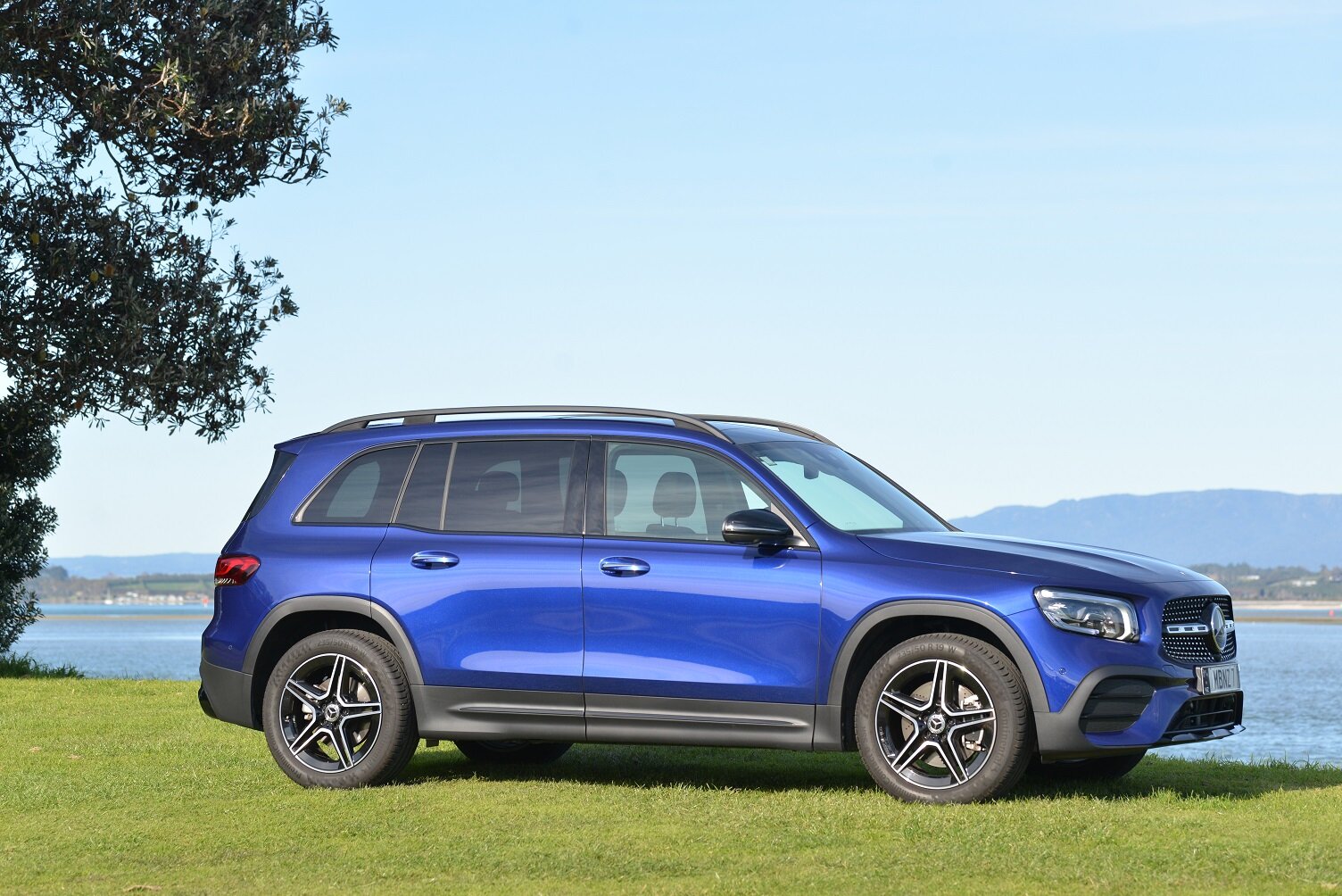
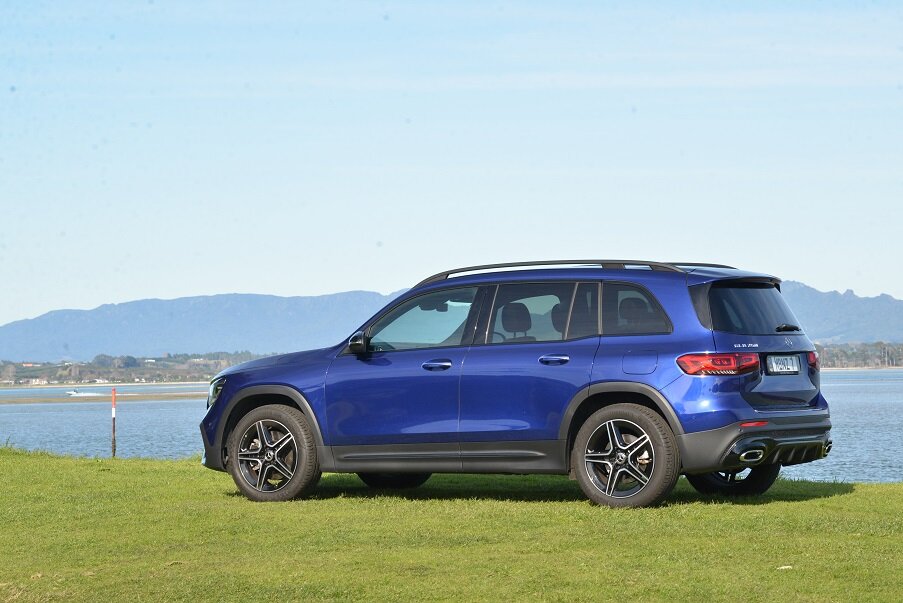
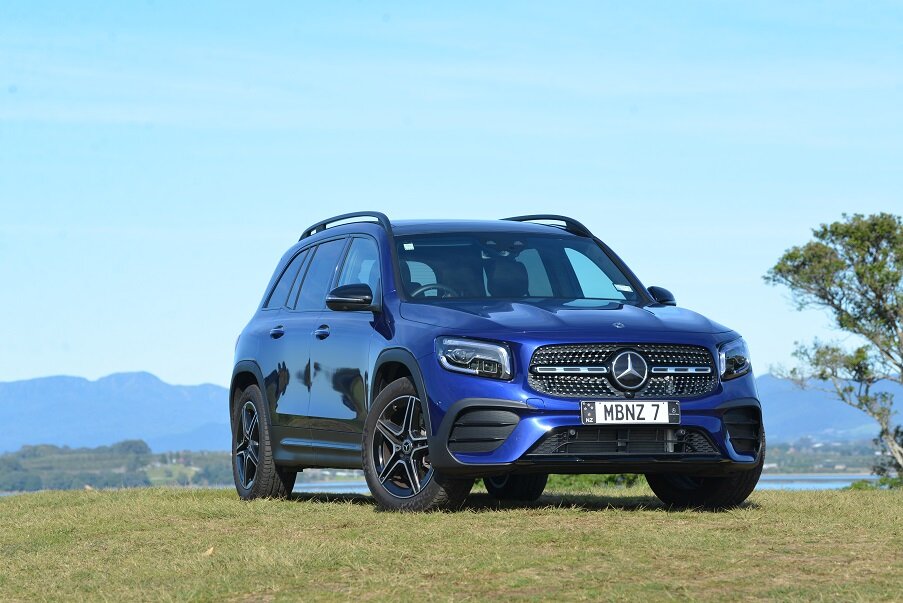
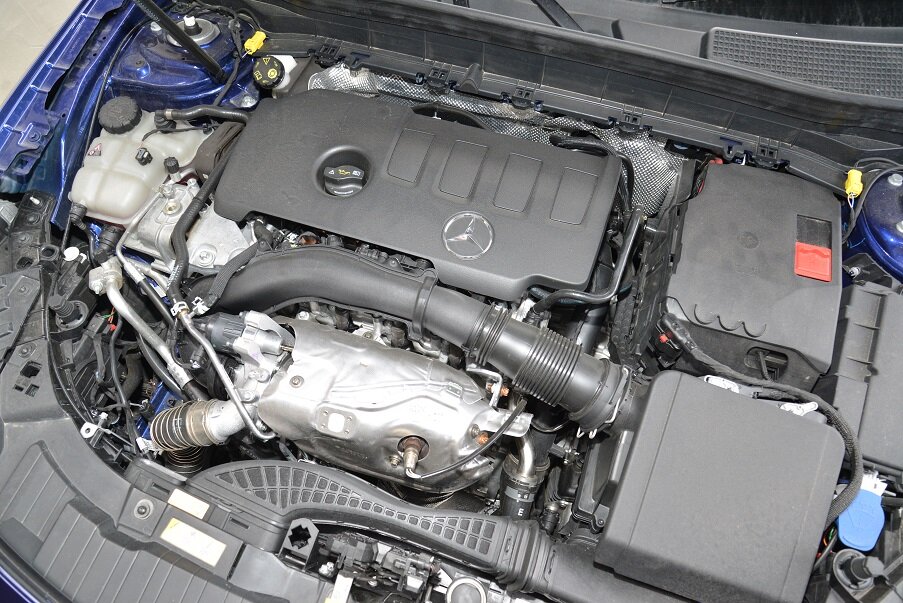
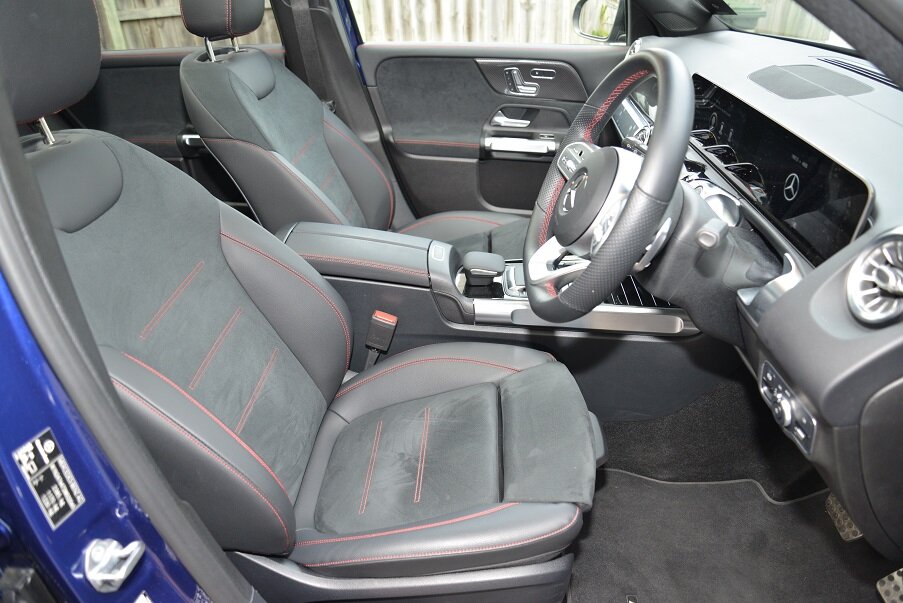

JAGUAR F-PACE SVR
Price: $157,900.
Powertrain: 5.0-litre supercharged petrol, 404kW/680Nm, AWD, combined economy 11.7 litres per 100km, 0-100kmh 4.3 seconds.
Vital statistics: 4740mm long, 1670mm high, 2874mm wheelbase, luggage capacity 508 litres, 22-inch wheels.
We like: Sledgehammer thrust, big boot, brazen attitude. We don't like: Dated infotainment, auto slower than a dual clutch.

MERCEDES-AMG C63 S Estate
Price: $170,800.
Powertrain: 4.0-litre biturbo petrol, 375kW/700Nm, RWD, combined economy 10.7 litres per 100km, 0-100kmh 4.1 seconds.
Vital statistics: 4771mm long, 1441mm high, 2840mm wheelbase, luggage capacity 490 litres, 19-inch wheels.
We like: Drives as well as other variants, roominess, build quality. We don't like: Axle tramp under hard acceleration, gear selector stalk.
JUST because performance V8s are ultimately doomed doesn’t mean they need depart quietly.
Ferocious growling is intrinsic to the Jaguar F-Pace SVR and the Mercedes-AMG C63 S estate.
Each delivers an exhaust timbre of such strength in full phwoar footing - the Brit supercharged 5.0-litre pushing out a touch deeper-throated bellow, even more off-throttle crackle-pop and a louder at-idle burble than Germany’s 4.0-litre biturbo bogan – there’s potential they’ll be heard before they are seen.
And yet, when the occasion calls for a less overt ambience … well, they can tone down the trumpeting quite considerably.
Such is life with multi-modal exhausts’ ability to suit the mood of any given moment. From a quiet ‘eco’ setting that’s primarily there to satisfy official sound check tests (and allow neighbourhood meltdown-avoiding early morning starts) to settings that progressively liberate more effusive sounds that are music to enthusiast ears. Perfect, right?

Best make the most of it. News unrolling during the period spent with these cars suggest change in the air will detune today’s high-intensity rumble.
European drive-by noise regulations have become less lenient. What’s okay now won’t be soon. AMG has already admitted future product will be quieter than it could have been as result.
For Jaguar, there’s this plus knowing the raucous AJ engine featuring here will become redundant anyway, with production ending next year. Talk is the replacement will be … gulp … BMW’s 4.4-litre eight. Sad faces at Special Vehicles Operations if M-Division muscles into their patch.
Even with less roar, they’ll still be raw. And yet, offering something you normally don’t expect with high performance. Another ‘p’ word.
Having a big power-operated tailgate and a swag of space behind it doesn’t seem to inhibit how those models go, but it surely must raise their status when fun and family consideration cannot avoid colliding
Jaguar has an extra edge in respect that the F-Pace meets the market’s SUV fascination, presenting in fully four-wheel-drive and costing $12,900 less than the rear-drive Benz. But either way, if there’s stuff to shift, they’re versatile load swallowers; asking just a little extra care not to besmirch their upmarket leather trims.
As said, the Bunnings-friendly format doesn’t diminish ability to crack on at crazy pace. They also optimal load for brawn and so not only have gold medal potential in their categories but run almost equally for optimal top speed and in the zero-to-100kmh sprint (where the AMG tops, with 4.1 seconds against the Brit’s 4.3). Top speeds are also in the headline-making 280kmh zone.

Fuel burn? Yup, they’re big on that though, surprisingly, with an average 10.6 litres per 100km from test, the AMG was actually 0.1 L/100km under the official combined claim while the Jag sat half a litre above the cited 11.7. Carbon dioxide emissions, another reason why these engines are ultimately doomed? Not flash. Jag at 272g/km, the bonker Benz 237.
The power of pedigree shapes up with extrovert stylings. Wheelarch extensions, rear diffusers, roof spoilers and unique alloys are common ingredients, but it’s the Jaguar that’s most warlike due to large air intakes in the front mudguards, bonnet vents and an incredibly vivid blue paint. The interiors of both also adapt to the task at hand, both running well-bolstered sports seats, the Jag’s with a cool quilted surface, and offering great, low-set driving positions.
I like that the SVR edition has a regular gear lever in place of the old rotary dial – so much more appropriate than the C-Class stalk shifter – though, in fairness, either way you soon find yourself running in Drive for everyday running then shifting into manual, and using the paddle shifts (AMG’s are better) when wanting to go hands on, which seems appropriate given their abilities. You need not go far to be reminded these are serious cars demanding respect and talent.
The supercharged V8’s strength is the wall of wallop, torque spanning from 2500-5500rpm is so unremitting in its oomph that you just find it hard to believe it is less muscular than the AMG. The all-wheel-drive element is hugely beneficial on winding roads; once through an apex, you can feed in more grunt more quickly than with the Benz, which tail-wags and might even briefly wheelspin if over-hurried.

Given that it carries more mass than the Merc and also has more air between its underside and the seal than any other road-legal performance Jag, you’d think it only fair to cut the F-Pace some slack. Assuredly, it seeks no such sympathy. With uprated dampers, firmer springs, a thicker anti-roll bar, huge brakes, a trick rear-axle mounted electronic active diff and high-performance tyres, it has the goods to undermine thought that SUVs are pushing their luck when being punted hard out.
You do need watch your surfaces. Even though the fronts will ultimately pull as forcefully as the rears push, most of the power goes to the rear wheels untill the system detects slippage. This, and the tyres’ often failing to cut through heavily-metalled sections, made for plenty of oversteer on a 40km of unsealed road I committed to from taking a wrong turn on a route I thought I knew better. The tail-wagging would have been more fun without the unwelcome elements of dizzying drops, blind corners and having to undertake an emergency avoidance of an own-the-road stock truck.
Using the AMG for an open road trek down country roads to bring back a replacement windscreen for my MX5 race car was a touch nerve-racking; since even on coarse chip in the ‘comfort’ setting, it’s a bit jittery. Would it crack? No. And neither did the screen.

Expensive to buy and keep. That’s how it goes with all performance cars. At least, with these, you get practicality with the polished punch and there’s absolutely no sense they’ve been executed with any less dedication than the sedans and coupes that generally hog the spotlight.
MotoringNZ reviews new cars and keeps readers up-to-date with the latest developments on the auto industry. All the major brands are represented. The site is owned and edited by New Zealand motoring journalist Richard Bosselman.